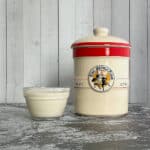
How to Feed Sourdough Starter
Are you new to sourdough baking or have questions about maintaining your sourdough starter? Here's all you need to know about how to feed your sourdough starter and how to tell when it's ready to bake with. Plus, ideas for what you can do with your unfed sourdough starter discard.
Servings: 2 cups
Calories: 116kcal
Special Equipment
Ingredients
- 2 cups sourdough starter, unfed, chilled or at room temperature
- 1 scant cup (113 grams) all-purpose flour, see Recipe Notes
- ½ cup (113 grams) water, warmed to 100 to 120°F
Instructions
- Remove the unfed sourdough starter container from the refrigerator if that's where it's kept. There may be a bit of light amber or clear liquid on top. Stir it back in to the starter or drain it off, your choice. Either way, it’s alcohol from the fermenting yeast and is perfectly fine.
- If you notice a strong, moldy or off-putting smell (like something rotten), or it has a pink or orange tint or streak, this is a sure sign that your sourdough starter has died. Don't use it! Just throw it away and get a new batch of sourdough starter.
- Place a 2-cup container on a kitchen scale and remove 1 cup (227 grams) of the unfed sourdough starter from your starter container. This is the unfed sourdough starter (aka sourdough starter discard). If you like to reuse the discard, loosely cover it and set it aside. Otherwise, you can share it with a friend or throw it away.
- Place the starter container on the scale. Measure 1 scant cup (113 grams) of all-purpose flour (see Recipe Notes) and add it to the starter.
- Warm the water in a microwave-safe measuring cup for 30 seconds or until it's warmed to 100 °F to 115 °F as read on a digital thermometer. Measure ½ cup (113 grams) of water and add it to the starter.
- Stir the starter well. Cover the starter container and set it aside on the counter.
- Allow the starter to rest at room temperature (about 70 °F) for 2 to 4 hours, or until it's bubbly with a nice yeasty smell and has risen up in the container. This means the yeast is active and ready to use.
- At this point you have a fed sourdough starter. If you're going to bake with the starter now, remove the amount you need and repeat the feeding process to replace what you've just taken. If you're not going to use the starter now, just return the starter container to the refrigerator (if that's where it's kept) until the next feeding time.
- You can bake with the sourdough discard now or return it to the refrigerator for future use.
Recipe Notes
My starter has a 1 : 1 recipe ratio of flour to water. That is, it has a 100% hydration level. If your hydration level is different from mine, you'll need to adjust the amount of flour in relation to the water accordingly.
You can also use different types of flours for different types of sourdough starter. I use King Arthur Baking's unbleached all-purpose flour to maintain my starter, which has a higher protein level than most all-purpose flours. You can use whole wheat flour, rye flour, bread flour, etc, as your flour of choice. Just be consistent and use the same type each time, if possible.
Nutrition
Serving: 1cup | Calories: 116kcal | Carbohydrates: 24g | Protein: 3g | Fat: 1g | Sodium: 5mg | Potassium: 1mg | Fiber: 1g | Calcium: 2mg | Iron: 1mg